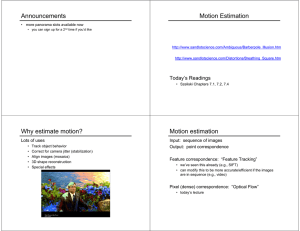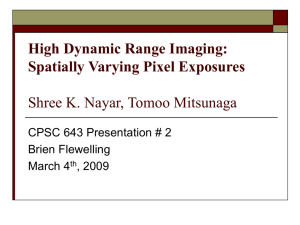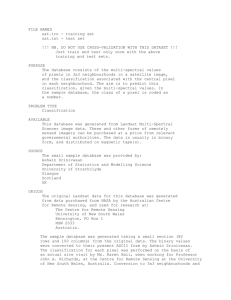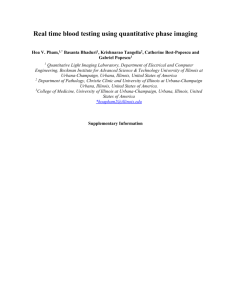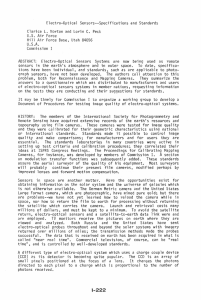ppt
advertisement
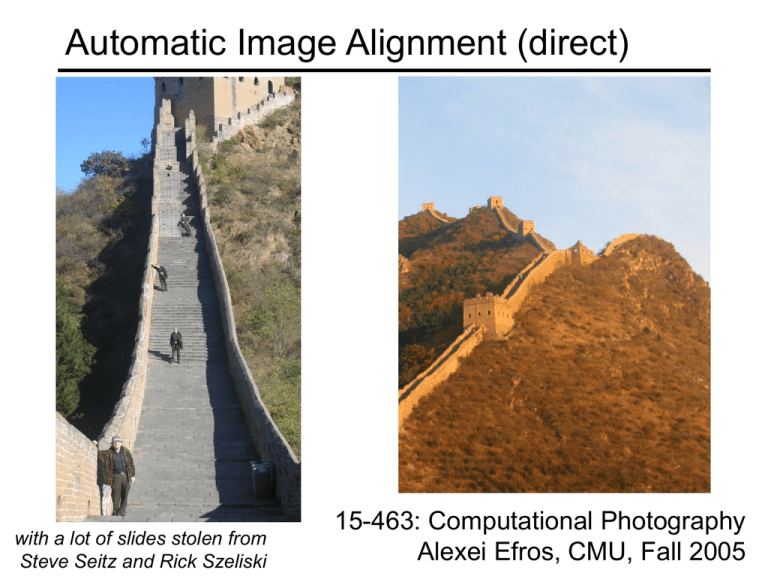
Automatic Image Alignment (direct) with a lot of slides stolen from Steve Seitz and Rick Szeliski 15-463: Computational Photography Alexei Efros, CMU, Fall 2005 Today Go over Midterm Go over Project #3 Start Automatic Alginment Reading: • Szeliski, Sections 3 and 4 Image Alignment How do we align two images automatically? Two broad approaches: • Feature-based alignment – Find a few matching features in both images – compute alignment • Direct (pixel-based) alignment – Search for alignment where most pixels agree Direct Alignment The simplest approach is a brute force search (hw1) • Need to define image matching function – SSD, Normalized Correlation, edge matching, etc. • Search over all parameters within a reasonable range: e.g. for translation: for tx=x0:step:x1, for ty=y0:step:y1, compare image1(x,y) to image2(x+tx,y+ty) end; end; Need to pick correct x0,x1 and step • What happens if step is too large? Direct Alignment (brute force) What if we want to search for more complicated transformation, e.g. homography? wx' a wy' d w g b e h c x f y i 1 for a=a0:astep:a1, for b=b0:bstep:b1, for c=c0:cstep:c1, for d=d0:dstep:d1, for e=e0:estep:e1, for f=f0:fstep:f1, for g=g0:gstep:g1, for h=h0:hstep:h1, compare image1 to H(image2) end; end; end; end; end; end; end; end; Problems with brute force Not realistic • Search in O(N8) is problematic • Not clear how to set starting/stopping value and step What can we do? • Use pyramid search to limit starting/stopping/step values • For special cases (rotational panoramas), can reduce search slightly to O(N4): – H = K1R1R2-1K2-1 (4 DOF: f and rotation) Alternative: gradient decent on the error function • i.e. how do I tweak my current estimate to make the SSD error go down? • Can do sub-pixel accuracy • BIG assumption? – Images are already almost aligned (<2 pixels difference!) – Can improve with pyramid • Same tool as in motion estimation Motion estimation: Optical flow Will start by estimating motion of each pixel separately Then will consider motion of entire image Why estimate motion? Lots of uses • • • • • Track object behavior Correct for camera jitter (stabilization) Align images (mosaics) 3D shape reconstruction Special effects Problem definition: optical flow How to estimate pixel motion from image H to image I? • Solve pixel correspondence problem – given a pixel in H, look for nearby pixels of the same color in I Key assumptions • color constancy: a point in H looks the same in I – For grayscale images, this is brightness constancy • small motion: points do not move very far This is called the optical flow problem Optical flow constraints (grayscale images) Let’s look at these constraints more closely • brightness constancy: Q: what’s the equation? • small motion: (u and v are less than 1 pixel) – suppose we take the Taylor series expansion of I: Optical flow equation Combining these two equations In the limit as u and v go to zero, this becomes exact Optical flow equation Q: how many unknowns and equations per pixel? Intuitively, what does this constraint mean? • The component of the flow in the gradient direction is determined • The component of the flow parallel to an edge is unknown This explains the Barber Pole illusion http://www.sandlotscience.com/Ambiguous/barberpole.htm Aperture problem Aperture problem Solving the aperture problem How to get more equations for a pixel? • Basic idea: impose additional constraints – most common is to assume that the flow field is smooth locally – one method: pretend the pixel’s neighbors have the same (u,v) » If we use a 5x5 window, that gives us 25 equations per pixel! RGB version How to get more equations for a pixel? • Basic idea: impose additional constraints – most common is to assume that the flow field is smooth locally – one method: pretend the pixel’s neighbors have the same (u,v) » If we use a 5x5 window, that gives us 25*3 equations per pixel! Lukas-Kanade flow Prob: we have more equations than unknowns Solution: solve least squares problem • minimum least squares solution given by solution (in d) of: • The summations are over all pixels in the K x K window • This technique was first proposed by Lukas & Kanade (1981) Conditions for solvability • Optimal (u, v) satisfies Lucas-Kanade equation When is This Solvable? • ATA should be invertible • ATA should not be too small due to noise – eigenvalues l1 and l2 of ATA should not be too small • ATA should be well-conditioned – l1/ l2 should not be too large (l1 = larger eigenvalue) ATA is solvable when there is no aperture problem Local Patch Analysis Edge – large gradients, all the same – large l1, small l2 Low texture region – gradients have small magnitude – small l1, small l2 High textured region – gradients are different, large magnitudes – large l1, large l2 Observation This is a two image problem BUT • Can measure sensitivity by just looking at one of the images! • This tells us which pixels are easy to track, which are hard – very useful later on when we do feature tracking... Errors in Lukas-Kanade What are the potential causes of errors in this procedure? • Suppose ATA is easily invertible • Suppose there is not much noise in the image When our assumptions are violated • Brightness constancy is not satisfied • The motion is not small • A point does not move like its neighbors – window size is too large – what is the ideal window size? Iterative Refinement Iterative Lukas-Kanade Algorithm 1. Estimate velocity at each pixel by solving Lucas-Kanade equations 2. Warp H towards I using the estimated flow field - use image warping techniques 3. Repeat until convergence Revisiting the small motion assumption Is this motion small enough? • Probably not—it’s much larger than one pixel (2nd order terms dominate) • How might we solve this problem? Reduce the resolution! Coarse-to-fine optical flow estimation u=1.25 pixels u=2.5 pixels u=5 pixels image H Gaussian pyramid of image H u=10 pixels image II image Gaussian pyramid of image I Coarse-to-fine optical flow estimation run iterative L-K warp & upsample run iterative L-K . . . image JH Gaussian pyramid of image H image II image Gaussian pyramid of image I Beyond Translation So far, our patch can only translate in (u,v) What about other motion models? • rotation, affine, perspective Same thing but need to add an appropriate Jacobian (see Table 2 in Szeliski handout): A A JI( I) J T T i A b J I t ( I) T T i T T Image alignment Goal: estimate single (u,v) translation for entire image • Easier subcase: solvable by pyramid-based Lukas-Kanade Lucas-Kanade for image alignment Pros: • All pixels get used in matching • Can get sub-pixel accuracy (important for good mosaicing!) • Relatively fast and simple Cons: • Prone to local minima • Images need to be already well-aligned What if, instead, we extract important “features” from the image and just align these? Feature-based alignment 1. Find a few important features (aka Interest Points) 2. Match them across two images 3. Compute image transformation as per Project #3 How do we choose good features? • • • • They must prominent in both images Easy to localize Think how you did that by hand in Project #3 Corners! Feature Detection Feature Matching How do we match the features between the images? • Need a way to describe a region around each feature – e.g. image patch around each feature • Use successful matches to estimate homography – Need to do something to get rid of outliers Issues: • What if the image patches for several interest points look similar? – Make patch size bigger • What if the image patches for the same feature look different due to scale, rotation, etc. – Need an invariant descriptor Invariant Feature Descriptors Schmid & Mohr 1997, Lowe 1999, Baumberg 2000, Tuytelaars & Van Gool 2000, Mikolajczyk & Schmid 2001, Brown & Lowe 2002, Matas et. al. 2002, Schaffalitzky & Zisserman 2002

